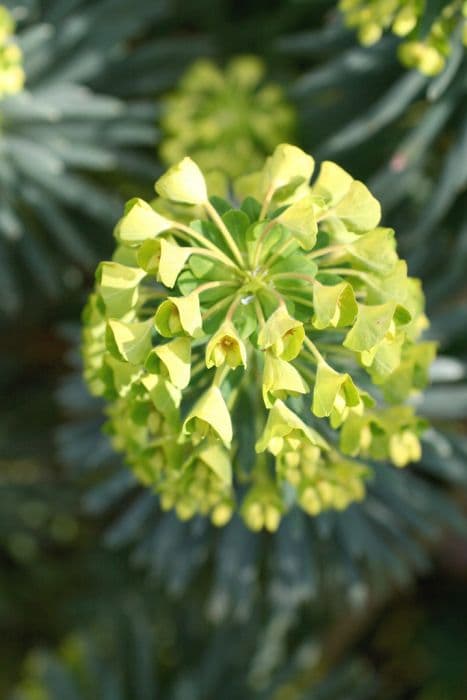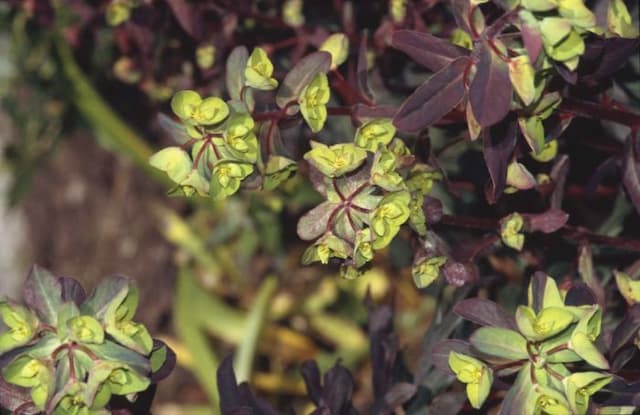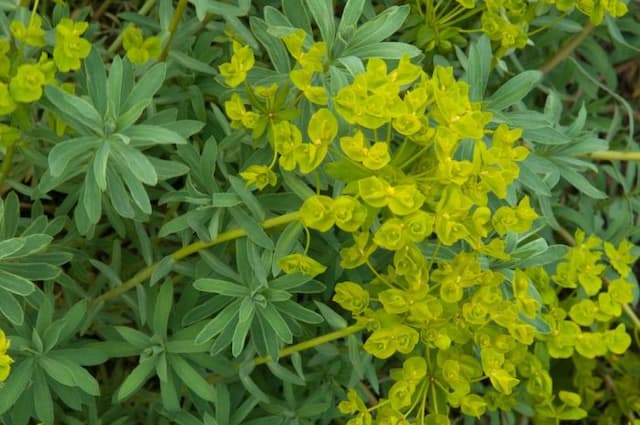Baseball plant Euphorbia obesa

ABOUT
Euphorbia obesa, also commonly known as the baseball plant, has a distinctive spherical shape reminiscent of the ball used in the American pastime. The body of the plant is green with a texture that is often compared to a leather-like surface. Over time, the green can become tinged with a reddish-brown, particularly when the plant has been exposed to bright sunlight. The surface of the baseball plant is divided into eight to ten vertical ridges, giving it a somewhat lobed appearance. Along these ridges, you'll notice small bumps or protrusions, which is where the plant's tiny leaves are produced. These leaves are ephemeral, meaning they don't last long before drying up and falling off, which is often so inconspicuous that it goes unnoticed. The baseball plant may also produce small, inconspicuous yellow flowers that emerge in a cluster at the top of the plant. These flowers are interesting because they don't have petals like typical flowering plants; instead, they are small and cup-like. Overall, the baseball plant’s appearance is characterized by its round shape, vertical ridges, leather-like texture, and its affinity for producing tiny leaves that are transient in nature. Its unique look makes it a favorite among succulent enthusiasts and an interesting specimen in any plant collection.
About this plant
 Names
NamesFamily
Euphorbiaceae.
Synonyms
Baseball Plant, Sea Urchin, Basketball Plant, Living Baseball, Gingham Golf Ball.
Common names
Euphorbia obesa.
 Toxicity
ToxicityTo humans
Euphorbia obesa, commonly known as baseball plant, contains a white, milky latex sap that is toxic to humans. If the sap comes into contact with skin, it can cause irritation, redness, and swelling. If the eyes are exposed, it can lead to severe pain and temporary blindness. Ingesting any part of this plant can result in a series of symptoms such as burning pain in the mouth and throat, stomach pain, vomiting, and diarrhea. In severe cases, ingestion could cause systemic reactions including weakness, difficulty breathing, and a rapid heart rate. It is important to handle this plant with care and to avoid ingesting any part of it to prevent the possible consequences of poisoning.
To pets
Euphorbia obesa, commonly known as baseball plant, poses a hazard for pets due to its toxic latex sap. If pets come into contact with the sap, it can cause skin irritation, and if they get the sap in their eyes, it may lead to pain and visual disturbances. Ingestion of any part of the baseball plant by pets can cause symptoms including vomiting, diarrhea, excessive drooling, and abdominal pain. In severe cases, the ingestion could lead to more serious health issues such as tremors, difficulty in breathing, and a decrease in heart rate. It is advisable to keep this plant out of reach of pets to avoid the risk of toxicity.
 Characteristics
CharacteristicsLife cycle
Perennials
Foliage type
Evergreen
Color of leaves
Green
Height
8 inches (20 cm)
Spread
3 feet (90 cm)
Plant type
Succulent
Hardiness zones
10
Native area
South Africa
Benefits
 General Benefits
General Benefits- Ornamental Value: Euphorbia obesa, commonly known as the Baseball Plant, is prized for its unique spherical shape and striking striped pattern, which provide decorative interest to homes and gardens.
- Drought Resistance: As a succulent, the Baseball Plant has the ability to store water and can survive periods of drought, making it a low-maintenance choice for xeriscaping and water-wise gardens.
- Easy Propagation: It can be easily propagated from seeds or cuttings, allowing gardeners to share and expand their collection without much hassle.
- Compact Size: The small, compact form of the Baseball Plant makes it ideal for cultivation in smaller spaces such as apartments, desktops, and windowsills.
- Long Lifespan: With proper care, Euphorbia obesa can live for many years, sometimes decades, providing a long-term presence in a plant collection.
- Minimal Care Requirements: It requires minimal attention in terms of watering, feeding, and pruning, which is perfect for those with busy lifestyles or novice plant owners.
- Resistance to Pests: The Baseball Plant is relatively resistant to pests, reducing the need for chemical treatments and promoting a more natural indoor environment.
- Interesting Flowering: Euphorbia obesa produces small, inconspicuous flowers that can be a conversation piece for plant enthusiasts interested in botany and plant biology.
 Medical Properties
Medical PropertiesThis plant is not used for medical purposes.
 Air-purifying Qualities
Air-purifying QualitiesThis plant is not specifically known for air purifying qualities.
 Other Uses
Other Uses- Euphorbia obesa can serve as a living decor in small spaces due to its compact spherical shape, making it ideal for miniature gardens or as part of a terrarium setup.
- As a conversation starter, the unique appearance of Euphorbia obesa, resembling a ball, can be a focal point in plant collections or educational displays.
- The plant is used in feng shui practices, where it is believed to bring positive energy due to its rounded form, which is associated with wealth and abundance.
- Euphorbia obesa can be used in artistic installations and botanical art pieces for its geometric and architecturally interesting form.
- It is utilized as a model organism in some scientific studies exploring plant resistance and adaptation to arid climates.
- The Euphorbia obesa’s ability to store water in its body allows it to be used in drought-tolerant landscaping, contributing to water conservation efforts.
- Owing to its slow growth and ease of maintenance, Euphorbia obesa is used as a beginner's plant to teach children about plant care and horticulture.
- Photographers and filmmakers sometimes use Euphorbia obesa for setting up naturalistic scenes in documentaries or photo shoots focused on succulents or desert flora.
- Craft individuals might use dried specimens of Euphorbia obesa for creating ornaments or decorative items where preserving greenery is desired.
- Euphorbia obesa seeds are used in seed exchange programs to promote biodiversity and the cultivation of rare and endangered plant species.
Interesting Facts
 Feng Shui
Feng ShuiThe Baseball Plant is not used in Feng Shui practice.
 Zodiac Sign Compitability
Zodiac Sign CompitabilityThe Baseball Plant is not used in astrology practice.
 Plant Symbolism
Plant Symbolism- Resilience: The Baseball Plant (Euphorbia obesa) can withstand harsh conditions and stores water in its spherical body, representing an ability to persevere and thrive in challenging environments.
- Uniqueness: With its distinct round shape and patterned skin, the Baseball Plant symbolizes individuality and the importance of embracing one's unique qualities.
- Adaptation: This plant's capacity to adapt to semi-desert areas demonstrates the quality of adaptability in life or situations.
- Longevity: The long lifespan of the Baseball Plant, which can live for many years, symbolizes endurance over time, wisdom, and lasting presence.
- Balanced Growth: The symmetrical growth pattern of the Baseball Plant embodies the idea of balanced and proportional development in various aspects of life.
 Water
WaterBaseball Plant requires moderate watering during active growth in spring and summer; water approximately every two weeks with 1/8 gallon of water, making sure the soil is dry between waterings. In the winter, when the plant is dormant, reduce watering frequency to once a month or less, providing just enough to prevent the soil from completely drying out. Over-watering can lead to root rot, so err on the side of underwatering rather than overwatering.
 Light
LightBaseball Plant thrives best in bright, indirect sunlight but can tolerate partial shade. Avoid exposing it to direct, harsh sunlight as it can cause sunburn on the plant's surface. The ideal location would be near a sunny window with some form of light filtering, such as sheer curtains, to diffuse the intensity of the direct sun.
 Temperature
TemperatureBaseball Plant prefers a warm climate and does well in temperatures ranging from 50 to 90 degrees Fahrenheit. The plant can tolerate a minimum temperature of 30 degrees Fahrenheit, but frost can be damaging, so it's best to keep it in temperatures above this threshold for optimal growth. Maintaining a consistent temperature around the 70s Fahrenheit is ideal for this plant.
 Pruning
PruningPruning is generally not needed for the Baseball Plant, as its growth habit is slow and it maintains an attractive round form naturally. If any dead or damaged material is present, it can be gently removed to maintain the plant's health. Pruning, if necessary, is best done in the spring or early summer when the plant is actively growing.
 Cleaning
CleaningAs needed
 Soil
SoilBaseball plant thrives in a well-draining soil mix, typically consisting of a cactus potting mix supplemented with perlite or sand to increase drainage. The ideal pH for Baseball plant should be slightly acidic to neutral, ranging from 6.0 to 7.0.
 Repotting
RepottingBaseball plant should be repotted every 2 to 3 years, or when the plant outgrows its current pot. As a slow-grower, it does not need frequent repotting.
 Humidity & Misting
Humidity & MistingBaseball plant prefers a dry environment, with low humidity levels being ideal. It is well-suited to the typical indoor atmosphere.
 Suitable locations
Suitable locationsIndoor
Place in bright, indirect light and avoid overwatering.
Outdoor
Position in light shade and protect from extreme weather.
Hardiness zone
9-11 USDA
 Life cycle
Life cycleEuphorbia obesa, commonly known as Baseball Plant, begins its life cycle as a seed, which, upon germination, develops into a small seedling with only a few leaves. As it matures, it grows into its characteristic spherical, ball-like shape that resembles a baseball, and becomes a slow-growing succulent. During adulthood, the Baseball Plant produces small, inconspicuous flowers located in the center of the plant, which are pollinated by insects, leading to the production of seeds. Given the right conditions, including a dry climate and infrequent watering that mimics its natural habitat, Euphorbia obesa can live for several decades. Unlike many plants, Euphorbia obesa is dioecious, meaning that male and female flowers are produced on separate plants, and both sexes are necessary for seed production. Eventually, as the plant ages, it may become more cylindrical and can start to produce offsets, or "pups", around its base, which can be separated to start new plants, continuing its life cycle.
 Propogation
PropogationPropogation time
Spring-Summer
Propogation: The Baseball Plant, scientifically known as Euphorbia obesa, is most commonly propagated using seeds. The best time to propagate by seeds is during the warm seasons, typically spring or summer, when the temperature ranges between 70-90°F (21-32°C). Seeds should be sown in a well-draining soil mixture, lightly covered with a thin layer of sand or the same soil mixture. They require a warm, humid environment to germinate effectively, so providing a greenhouse-like condition by covering the seed container with a clear plastic lid can be beneficial. It’s crucial to keep the soil consistently moist but not waterlogged during this time. Germination can take anywhere from one to four weeks, after which the seedlings can be carefully transplanted into their own pots once they are a manageable size and have developed a few true leaves.









